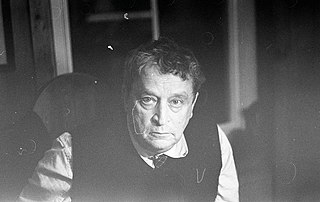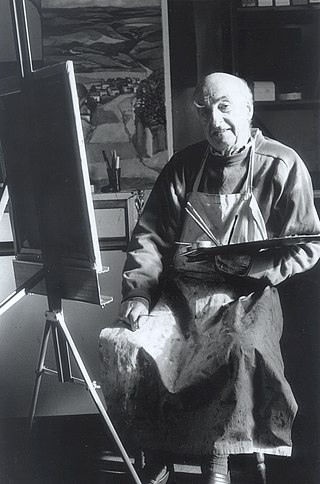John Graham Kettley is an English freelance weather forecaster.
BBC Radio Nottingham is the BBC's local radio station serving the county of Nottinghamshire.
Keith Spencer Waterhouse was a British novelist and newspaper columnist and the writer of many television series.

Sir Roland Algernon Penrose was an English artist, historian and poet. He was a major promoter and collector of modern art and an associate of the surrealists in the United Kingdom. During the Second World War he put his artistic skills to practical use as a teacher of camouflage.
John Keith Vaughan, was a British painter. His work is held in the collections of the Government Art Collection, National Galleries Scotland, National Portrait Gallery, Tate and Victoria and Albert Museum in the UK.
The West Bridgford School is a co-educational comprehensive school with academy status in West Bridgford, Nottinghamshire, England.

Sir Norman Rosenthal is a British independent curator and art historian. From 1970 to 1974 he was Exhibitions Officer at Brighton Museum and Art Gallery. In 1974 he became a curator at the Institute of Contemporary Arts, London, leaving in 1976. The following year, in 1977, he joined the Royal Academy in London as Exhibitions Secretary where he remained until his resignation in 2008. Rosenthal has been a trustee of numerous different national and international cultural organisations since the 1980s; he is currently on the board of English National Ballet. In 2007, he was awarded a knighthood in the Queen's Birthday Honours List. Rosenthal is well known for his support of contemporary art, and is particularly associated with the German artists Joseph Beuys, Georg Baselitz, Anselm Kiefer and Julian Schnabel, the Italian painter Francesco Clemente, and the generation of British artists that came to prominence in the early 1990s known as the YBAs.

BBC East Midlands is the BBC English Region covering Derbyshire, Leicestershire, Nottinghamshire, Rutland, South Kesteven in Lincolnshire and some northern parts of Northamptonshire.

Trowell services is a motorway service station off the M1 motorway in Trowell, Nottinghamshire, England, situated north of Junction 25. Opened in 1967 by Mecca Leisure, it is currently owned by Moto. The services are situated near Nottingham.
Top of the Form was a BBC radio and television quiz show for teams from secondary schools in the United Kingdom which ran for 38 years, from 1948 to 1986.

Robin Page was a British painter. He was one of the early members of the Fluxus art movement.
Cybernetic Serendipity was an exhibition of cybernetic art curated by Jasia Reichardt, shown at the Institute of Contemporary Arts, London, England, from 2 August to 20 October 1968, and then toured across the United States. Two stops in the United States were the Corcoran Annex, Washington, D.C., from 16 July to 31 August 1969, and the newly opened Exploratorium in San Francisco, from 1 November to 18 December 1969.
Founded in 1843, the School of Art & Design at Nottingham Trent University is one of the oldest in the United Kingdom.

Alexander George Gurney was an Australian artist, caricaturist, and cartoonist born at Pasley House, Stoke, Devonport, England, famous for his creation of two famous Australian comic strips: Ben Bowyang, and Bluey and Curley.

John Hooper Harvey was an English architectural historian, who specialised in writing on English Gothic architecture and architects. Paul Crossley has described him as "the most prolific and arguably the most influential writer on Gothic architecture in the post-war years". He made extensive use of archival sources, and is particularly remembered for having – through his study of Henry Yevele (1944), and his biographical dictionary of English Mediaeval Architects (1954) – helped dispel the myth that the architects of medieval buildings were anonymous figures of whom little could be discovered. He also published more generally on England in the later middle ages, and was a pioneer in the field of garden history.

William John Elwyn Davies, professionally known as John Elwyn, was a Welsh painter, illustrator and educator.
Roderic Barrett (1920–2000) was a British painter from Colchester, England.
Antonin Karel Bartl or Tony Bartl was a Czech artist who in 1947 came to Britain and established himself as an artist, through his connections with Dr Richard Weck, his brother in law, who became Director of The Welding Institute. In 1948 he joined the staff of Lincoln College of Art. In 1972 he arranged a major exhibition at the Usher Gallery, Lincoln of the works of John Piper and his artwork and mosaics were widely used to decorate a number of public buildings and on these projects he worked closely with the Lincoln architect Sam Scorer.
Richard Levin OBE was the former head of design at BBC Television from 1953 to 1971, and gave the BBC its modern look in the late 1960s, when colour television was innovatively introduced. As a stage designer, he had been drafted in as head of camouflage for the Air Ministry during the Battle of Britain.
Paul Anthony Hickson was a British former swimming coach, originally from Leicestershire. He coached the British Olympic swimming team at two Olympics in the 1980s, but behind his sporting prowess, he had been a determined and devious serial rapist of teenage female swimmers, who had misplaced their trust in him.









